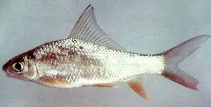| Family: |
Cyprinidae (Minnows or carps), subfamily: Labeoninae |
| Max. size: |
20 cm SL (male/unsexed) |
| Environment: |
benthopelagic; freshwater; brackish, potamodromous |
| Distribution: |
Asia: Chao Phraya and lower Mekong basins. |
| Diagnosis: |
Dorsal spines (total): 0-0; Dorsal soft rays (total): 14-16; Vertebrae: 34-35. Predorsal profile relatively steep; rostral barbels well developed, length more than one-half eye diameter; maxillary barbels absent. Somewhat similar to the much larger species C. molitorella, from where it differs markedly in coloration. Also, it is deeper bodied, especially anteriorly, and has a larger, more falcate anal fin, the distal end of which extends posteriorly to below posteriormost scales on caudal fin (Ref. 33488); 13-14 branched dorsal-fin rays; 65-68 gill rakers on lower arm of first arch; faint dark blotch on body above pectoral fin; smooth upper lip, lower lip weakly papillate (Ref. 12693). Body without reticulate pattern; pectoral, pelvic, anal and lower caudal lobe usually bright red (Ref. 43281). |
| Biology: |
Inhabits midwater to bottom depths of rivers, occurring in the main stem and on the floodplains, including freshwater areas that undergo tidal fluctuation. Feeds on algae, detritus and occasionally benthic invertebrates. Often marketed fresh and used to make prahoc (Ref. 12693). |
| IUCN Red List Status: |
Data deficient (DD); Date assessed: 17 February 2011 Ref. (130435)
|
| Threat to humans: |
harmless |
Source and more info: www.fishbase.org. For personal, classroom, and other internal use only. Not for publication.

